Find out what equipment we use to explore Cornwall’s Mines
When you join us to explore a mine in Cornwall, one of the first questions you may well ask, is what do mine explorers wear? Isn’t it wet, muddy and cold? The answer to that is yes, it is! And that is why, as is the case when participating in any adventurous activity, that we need to be properly dressed and equipped before we begin any underground adventure. Luckily for you, Cornwall Underground Adventures provides all the specialist equipment needed for you to go underground in Cornwall in comfort and safety. There are, however, a few items you do need to bring.
The list is short and simple. You simply need to bring some old clothes you can wear underneath the caving suit we provide for you. Don’t wear your best clothes, as there is always the chance that a stray bit of mud or water may get into your suit. Due to the high metal content of the mud found in Cornwall’s mines, this mud does have a tendency to stain! Whatever the time of year, we suggest full length clothes, as it may be colder than expected underground. Also, a layer of clothing between you and the caving suit is advisable, as the tough material of the caving suit doesn’t feel very pleasant against bare skin. Something like a track suit is ideal, as well as a choice of layers, especially for your top half. Note that jackets don’t fit very well underneath a caving suit.
The other essential item you’re advised to bring, is a spare pair of socks. We’ll be providing you with wellies, but it’s possible that you might get wet feet. So, knowing that a spare pair of socks is waiting for you at the car will be a comforting thought, once the trip is over.
What Equipment is Provided for Mine Exploration?
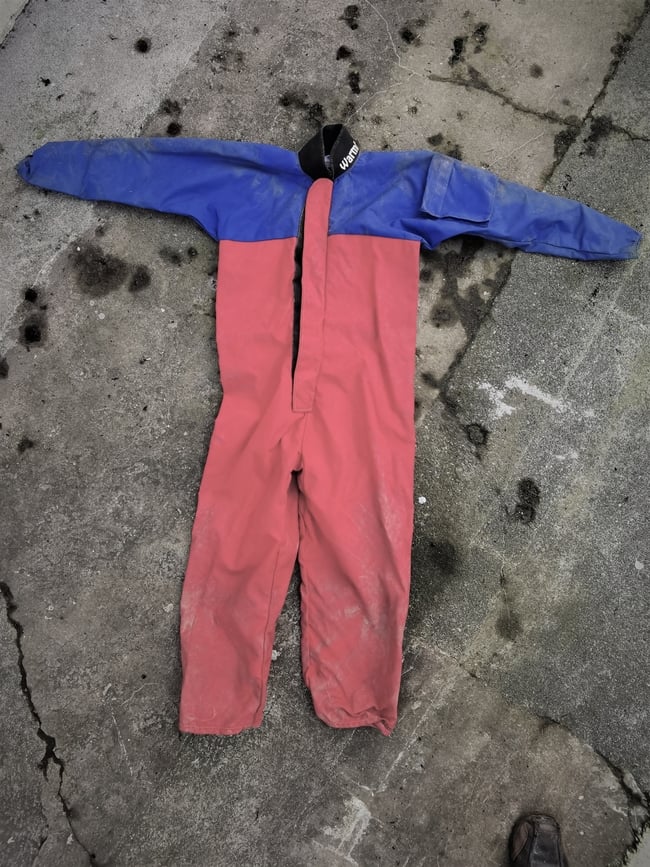
Most of the people who come on of our mine exploration trips are not active cavers, so we do not expect you to have any of the specialist gear needed to venture into a Cornish mine in style. That is why we provide good quality equipment for each and every one of our guests. What we do need you to do is provide the heights, builds, and shoe sizes of everyone in your group, to ensure we bring the correct equipment for you. We will ask for this information during the booking process.
Caving Suit
First and foremost, we have the caving suit. We have suits to fit all people of all shapes and sizes, from the largest, right down to the youngest cavers we can take underground. We use caving oversuits made by Warmbac. Warmbac are a Westcountry based company, founded in 1972, and are known worldwide for producing quality equipment for cave and mine explorers.
What does a caving suit do? A caving oversuit , strictly speaking, fulfils several roles at once. Made of tough material, it protects the wearer from the many grazes and bumps that would inevitably occur whilst wriggling around under the earth’s surface. Being water resistant, you can’t go swimming in them, but they will keep the worst of the damp and mud on the outside and not inside of the suit. Finally, they provide another layer and serve to help keep us warm in the dark underground environment. All in all, a fairly essential bit of kit!
Footwear for mine exploration
It’s easy to overlook what we wear on our feet when exploring underground. Like caves, the mines of Cornwall can have more than their fair share of mud, and there can even be sections where it’s necessary to slosh around in water several inches deep. OK, so sometimes when we’re exploring mines in Cornwall, the water can be much deeper, but don’t worry, we won’t be subjecting you to that on any of our guided mine explorations. Most types of footwear aren’t going to cut it in this wet and muddy environment.
Cue our friend, the humble wellington boot. That’s right, the simplest of footwear choices comes into its own in the underground environment, and is the only choice cavers tend to go for. As with all things, there can be a mid-boggling array of wellies to choose from, and some mine explorers prefer the added safety offered by a steel toe-cap wellington. These are a bit heavy duty for a one-off foray into an abandoned mine, so we use wellies by Dunlop for our guests. The top-quality rubber material ensures the best possible grip. Once you have gotten used to the feel of rubber on your feet, you’ll be surprised just how good they can be for climbing the walls of Cornish mines!
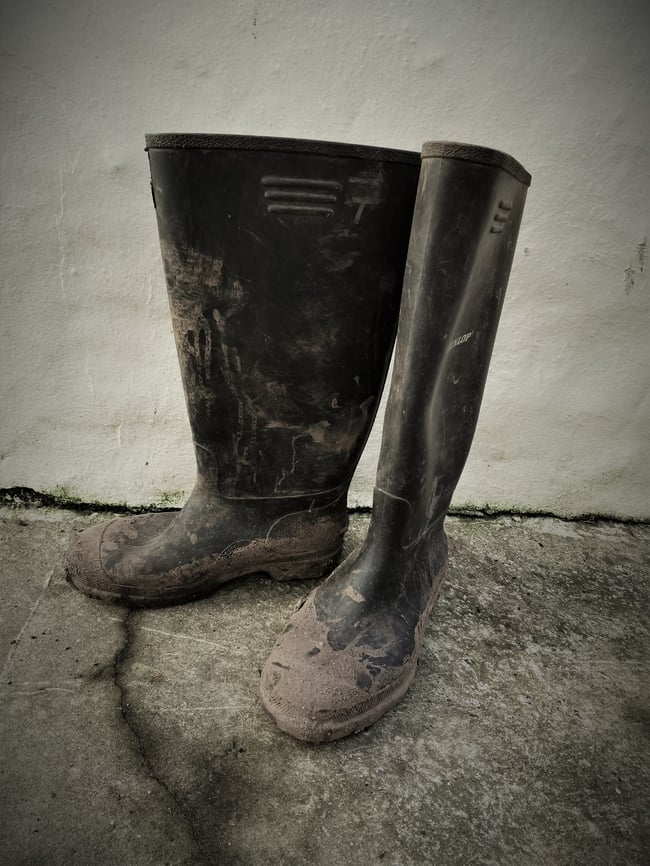
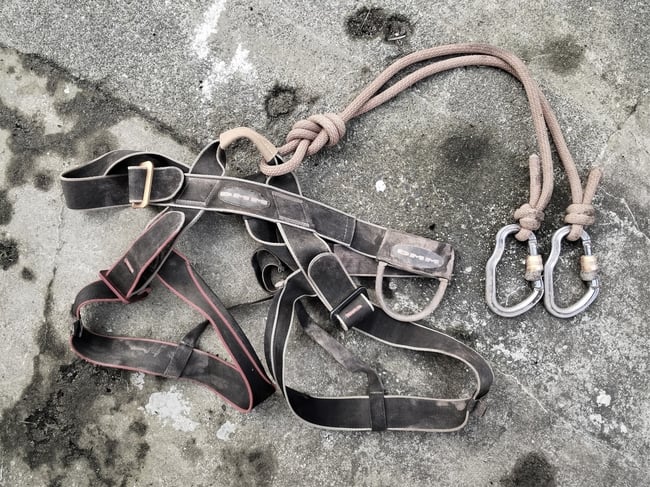
Harnesses For Caving
Whatever level of underground trip you decided to come on with us, you will be wearing a harness. This is the main attachment point for any rope manoeuvres, such as abseiling. It is also just a convenient point to pull somebody from, if they need and extra help. Caving harnesses can be quite complex, with multiple parts, some going over your shoulders, and usually with some kind of metal ‘D-ring’ that holds them together. These special caving harnesses allow experienced cavers to perform a number of feats going up and down ropes. However, they are unnecessarily complicated for the scope of our trips, so we use much simpler, rock climbing-style harnesses. These are more than adequate for abseiling and traversing large holes and are infinitely simpler to get inexperienced people in and out of.
Additional to the harness, those of you joining our Underground Adventurer trip, will have a set of ‘cowstails’ attached to your harness. Cowstails consists of two strands of dynamic rope, each with a locking carabiner. This is a crucial piece of equipment that allows us to safely traverse along ropes that have been fixed to the walls of the mine.
Following a thorough safety briefing, armed with your harness and cowstails, you’ll now be able to safely cross gaping mineshafts, ascend and descend ladders, as well and climb up and down the deep chasms of the mines, known as ‘stopes’, or in Cornish parlance, a ‘gunnis’. Our carabiner of choice for this task is the Petzl Wire-lock carabiner. We feel that this carabiner strikes the right balance between being adequately secure, without being too tricky for inexperienced hands to open, when required.
...Armed with your harness and cowstails, you’ll now be able to safely cross gaping mineshafts, ascend and descend ladders, as well and climb up and down the deep chasms of the mines...
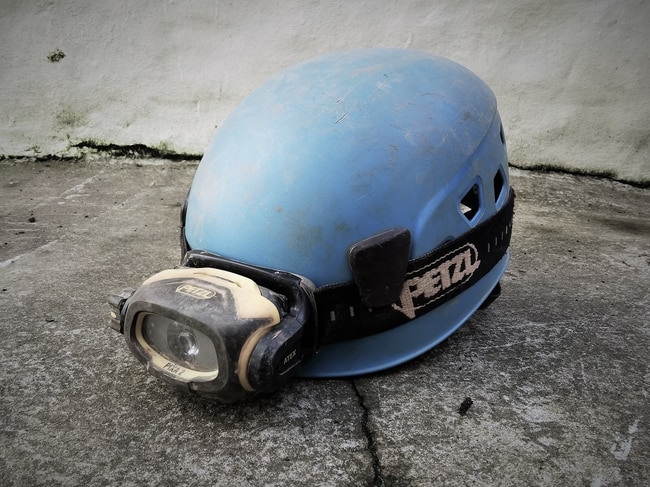
Helmet
It goes without saying, helmets are a requirement when going underground. Once again, we look to Petzl, who are world leaders in all kinds of equipment for caving, climbing and rope access activities. We currently use the Petzl Panga – a fantastic helmet with one size that literally fits all. Helmets, at the very minimum, they prevent us from banging our heads on any low roofs. Obviously, they could potentially be a life-saving bit of kit, in the unlikely event of rockfall, or someone falling from height. They also provide somewhere very convenient to hold your…
Head Torch
Without this little piece of kit, all of the above equipment is meaningless. With absolutely no light anywhere in a Cornish mine, progress of anything more than a few feet below grass is basically impossible. Handheld sources of light, such as traditional torches are impractical, as we always need at least one to be occupied holding the torch. Thus, the helmet-mounted head torch is the only practical means of lighting the way underground.
Again, the choice of lighting for cavers is bewildering. A cheap and cheerful hiking head torch can get you safely through a trip, but it won’t provide enough light for you to fully enjoy exploring the underground space. At the other end of the scale, the lamps made by Scurion are arguably the best in the world. Practically indestructible, ridiculously bright, and fully waterproof, so you can even go cave and mine diving with them. Once again, we use head torches made by our good friends at Petzl. The Petzl Pixa 2 serves us perfectly, giving a good level of light as well as more than enough battery life for even our longest trips.
What Additional Equipment Will Your Mine Leader Carry?
When on one of our guided trips, you will notice that your instructor may be wearing very similar equipment to yourself. Same same, but different, as they say. As well as regularly leadings trips for Cornwall Underground Adventures, our instructors are all avid mine explorers. So, spending lots of time underground, you can expect them to be wearing higher spec gear, such as more robust caving suits, and much better head torches.
Especially on the Underground Adventurer, your instructor will probably be wearing a very different harness to your simple climbing harness. What they have, is a ‘proper’ caving harness, one designed specifically for SRT (single rope technique), and is much more suited for advanced caving techniques, moving up and down ropes. A caving harness, with a central ‘D’ ring and a combined chest harness, provides maximum safety and comfort for abseiling long pitches, as well as using ascenders to climb back up the ropes to reach the surface.
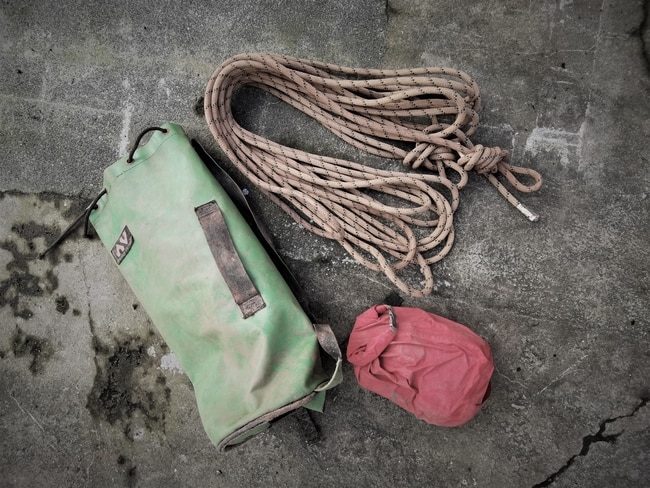
Your instructor will also be carrying any extra group equipment needed for the trip, all carried conveniently in a caving bag. These bags, made of hard-wearing material, are purposefully designed to withstand the rigours of caving. Their elongated, cylindrical design, is ideal for negotiating any tight gaps that may be encountered. They are also perfectly shaped for carrying a length of rope, which can be used for abseiling, or rigging traverse lines to safely cross chasms and shafts.
Modern rope techniques require extra pieces of hardware, to be used in conjunction with ropes – gone are the days of simply tying a rope around one’s waist for safety! Thus, your instructor will be carrying the required number of metal carabiners required for the trip. There will be several different types, each with subtly different functions, but in essence they all serve to connect a rope to either a fixed metal bolt, or to a person, via their harness. Hopefully you will never see it, but inside the caving bag will also be an emergency bag, just in case!
What Did the Cornish Miners Wear?
So, now you know that you can expect to be well-equipped with the latest modern equipment for your underground adventure. This is a far cry from the equipment used by the Old Men* who carved out the tunnels that we explore. With some of the workings you will explore being up to three hundred years old, you can imagine what the Cornish Miners wore and used would have been very different to what we use today.
Let’s compare what the miners of old would have had instead of the individual items that we consider essential today.
Firstly, the caving suit. There was simply no such thing. The miners would have worn simple flannel trousers, shirts and overcoats. Some of the mines were exceptionally hot and, due to this and a combination of the very physical nature of the work that they were doing, the miners would often be stripped down to their trousers whilst they worked. Not all mines were known to be baking hot, but some were staggeringly warm places to have had to work.
Data collected by Captain Josiah Thomas in Cornwall’s deepest mine, Dolcoath, in the 1880s recorded as figures as high as 83° Fahrenheit (28° Celsius) at the 352-fathom level (647metres below the surface). Some mines were even more extreme. In 1864, the water in the aptly named Hot Lode of United Mines in the Gwennap District reached 126° Fahrenheit (52°C). Also, well-named, Cook’s Kitchen Mine had stable temperatures in the order of 100°F (38°C).
For miners in these conditions, not having enough clothing would not have been an issue. Such deep levels would have quickly filled with water as soon as the mines were abandoned and the pumps stopped working. Therefore, it’s no longer possible to visit these sauna-like levels to experience this for ourselves.
Although invented by Arthur Wellesley, 1st Duke of Wellington, in 1817, the Wellington boot was not the footwear worn by the Cornish miners. Its first iteration saw it as a popular riding boot among the English gentry. It was not until conditions in the First World War trenches necessitated a truly waterproof boot, that something resembling the rubber boots that we know today, started to take shape. Instead, the miners had simple leather boots. They would have not offered too much in the way of water-proofing. So, on top of all the other ailments and injuries a career in the mines would ensure, terrible feet must have been a real problem as well.
The miners also impregnated the soles of their shoes with hobnails. This would give them a more secure footing as they moved around their workplace, as well as extend the life of their soles. These boots would leave distinctive prints on the floors of the tunnels in which they worked. So, hundreds of years later when we are exploring a mine for the first time, if we are lucky, we may see the footprints of the last men to have walked here, all that time ago.
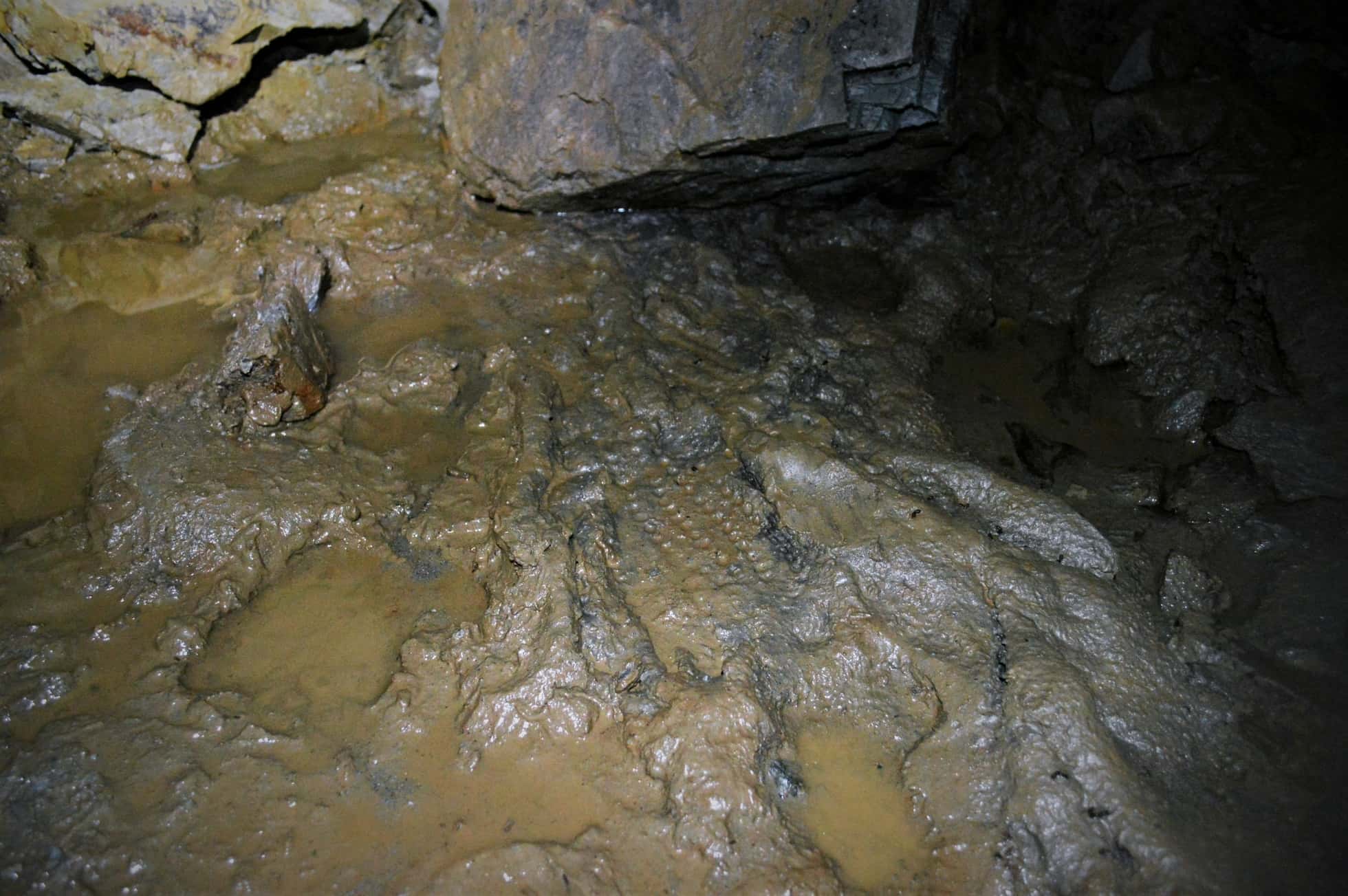
The climbing harness wasn’t invented until the end of the nineteenth century. What’s more, for a climbing harness to be of any use, it needs to be used in conjunction with ropes. The use of ropes is the absolute standard way that modern cavers and mine explorers negotiate the underground, using SRT (single rope technique). However, these techniques, and the equipment required to do so, are a relatively modern invention.
Cornish mines used kilometres of rope, but the ropes were only used for hauling the kibbles of ore, and other similar purposes. Everything the Cornish miners did was completely unsafeguarded and without and backup. They would install ladders to move vertically, sometimes climbing hundreds of feet to exit the deepest levels of the mines. To move horizontally, they would install timber stulls between the walls of the stopes and place planks across them to walk on. Needless to say, this was a very dangerous practice, and accidents were, sadly, commonplace. It’s very reassuring to be able to explore even the most vertical abandoned mines in safety with modern single rope techniques.
Well, surely the miners wore helmets? Alas, not really. The best they could devise was resin-hardened hats, usually made from felt, or a similar material. It would have doubtlessly given adequate protection from simply banging one’s head, and maybe deflecting the smallest stones falling from height. But for anything else, it must have been fairly useless. Similar to our modern ergonomically designed, plastic helmets, their hats would have served one key function, and that is to be a convenient place to mount the light source.
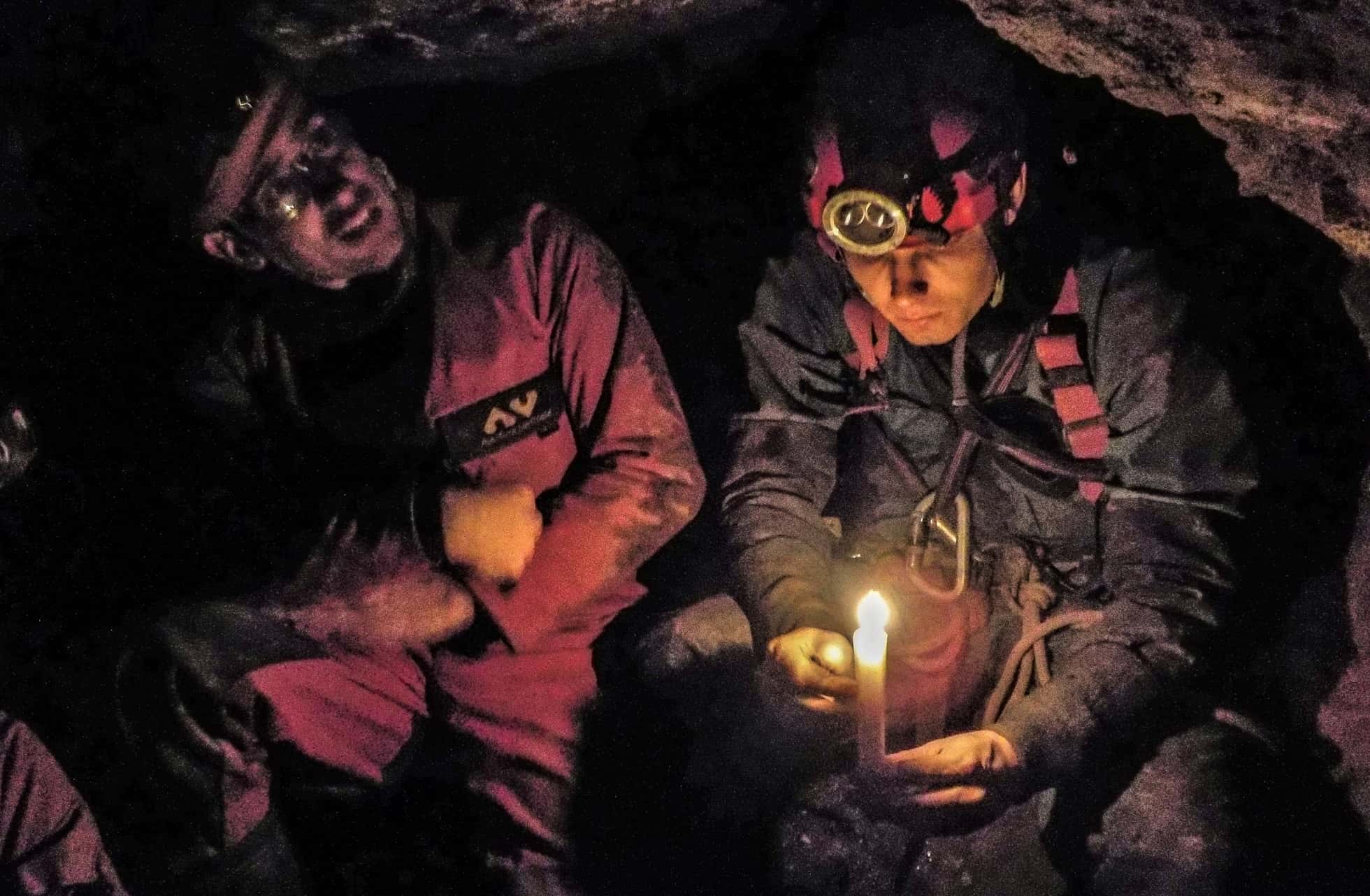
As with all things in this kit-list, we’re spoilt today, with every item of our equipment being many times better than that which the miners had at their disposal. Nowhere is this more evident than with lighting. Well into the twentieth century, despite numerous advances in mining technology, it was naught but the humble candle that was the only source of light for the men working underground. Even the most basic head torch today will be many times superior to a candle. And when you go underground with us, your guide will give you a demonstration of just how different the subterranean world looked to the miners’ eyes. Their field of vision would have been much less, greatly increasing the dangers of being underground, as well as making the whole reason they were there, to find tin and copper, all the more difficult.
Candles were a precious commodity. The miners either had to make their own, from animal fat, or they would be given a daily ration by the owners of the mine, typically six candles. Using extra candles would have incurred extra cost, so the miners use them sparingly, snuffing them out when not needed. For example, when leaving their ‘pitch’ (the section they were mining), to return to the surface, if they knew the way well, and there were no dangerous holes en route, they would simply traverse this section of the mine in darkness, to preserve candlelight. Lads as young as ten, upon starting their careers underground, may have spent their first few years simply wheelbarrowing loads of rocks back on forth along levels without any source of light whatsoever!
As well as leading people on adventures underground, a big part of what we do is try and bring these places to life and help people understand what the miens of Cornwall were like for the men who worked in them. As you can see, even take a look at the clothing and equipment we use offers a stark contrast between going caving for enjoyment with today’s modern equipment, versus going underground to work a hundred, or more years ago. It certainly gives us a whole new appreciation for our caving suits and humble wellington boots!
*A term the Cornish use for the miners who came before them.
Sources:
https://www.nmrs.org.uk/assets/pdf/BM3/BM3-16-20-temperature.pdf
https://www.coruba.co.uk/blog/the-history-of-the-wellington-boot/





